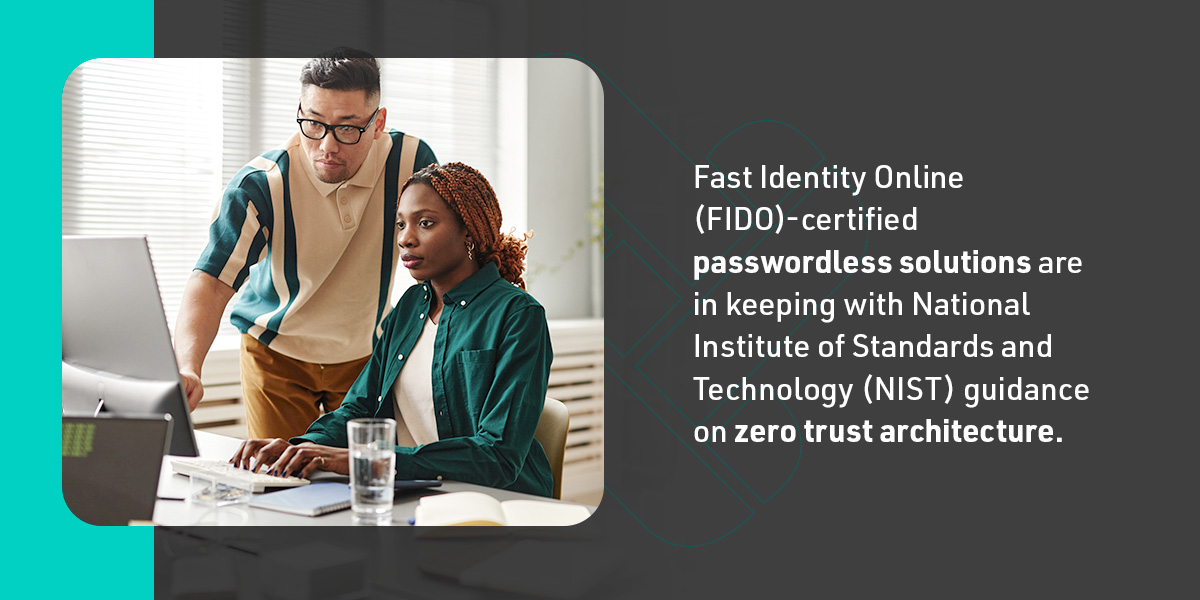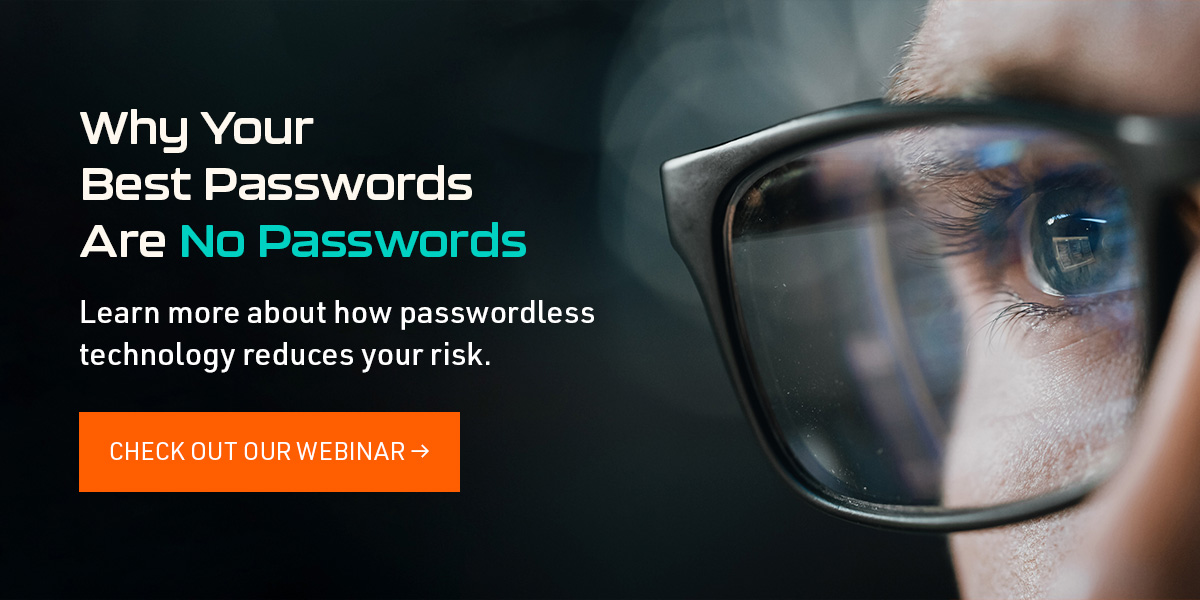You deal with dozens of passwords on a daily basis, both inside and outside the workplace. But with today’s increasingly complex cyberattacks, reliance on password authentication is no longer enough to protect your organization. Moving to passwordless security is the way of the future.
In This Article
- What Are the Risks of Using Passwords?
- What Is Passwordless Security?
- The Benefits of Passwordless Authentication
- The Top 3 Reasons to Adopt MFA and Passwordless Tech
- Bravura Security Passwordless Solutions
- Why Your Best Passwords Are No Passwords
What Are the Risks of Using Passwords?
Passwords can be significant safety risks. Attackers can steal or guess your passwords in brute force attacks to gain access to your accounts. Stolen credentials, phishing, misuse or basic human error accounted for 82% of breaches in 2021, a number that is likely to rise. While cyberattacks have gotten more sophisticated over the years, companies have been slow to catch up.
Although they’ve been a staple in the cybersecurity world for years now, multi-factor authentication (MFA) — including legacy two-factor authentication (2FA) — isn’t as secure as it used to be. Traditional MFA requires you to log in using a combination of:
- Something you know, like a password or personal identification number (PIN).
- Something you have, like a push notification prompt on your phone, computer or another device.
- Something you are, like biometric credentials such as fingerprint scans or facial recognition.
As you may have noticed, legacy MFA typically still uses passwords. If attackers steal your password or PIN, they just need to find a way to compromise your second factor to get in. MFA attacks have skyrocketed over the past year — just consider the September 2022 Twilio and Uber hacks.
An MFA prompt bombing attack usually begins when an attacker manages to get hold of someone’s credentials. Then, they start sending MFA requests, often through push notifications on the victim’s phone or computer. While the second authentication factor can stop or slow an attack, more sophisticated cybercriminals will use these tactics to break into your system.
So how can you protect your system if the tried-and-true methods are dead? Enter passwordless security.
What Is Passwordless Security?
As the name implies, passwordless security verifies your identity without ever dealing with passwords. Instead, it uses alternative authentication factors like:
- Possession factors: You unlock your account through something you own, like a hardware token or mobile authenticator app.
- Biometrics: A passwordless system might authenticate your identity through physical characteristics, such as your fingerprint and retina scans or even behavioral traits, such as typing patterns.
- Magic links: You can receive a magic link to enter your account via an email or SMS message.
Note that you don’t have to remember your passwords at any step of the process. This is why passwordless is the way of the future.
How Secure Is Passwordless?
Passwordless authentication is more secure because it eliminates your biggest attack surface--something you know. In doing so, it blocks phishers and other would-be attackers from gaining an initial foothold.
That said, your coverage will vary depending on the specific software you use. You want to choose a passwordless solution that provides a positive user experience, boosts productivity and meets critical compliance and cyber insurance demands.
The Benefits of Passwordless Authentication
Traditional authentication methods using passwords depend on centralized directories to store essential user information such as credentials, access, rights and job roles. These directories are high-value attack surfaces.
On the other hand, passwordless authentication enhances your security posture and helps you follow cybersecurity best practices. Here are some of the top benefits:
- Desktop to cloud coverage: Software as a service (SaaS) sprawl and password sprawl are serious issues plaguing many organizations. Passwordless authentication provides unified coverage across your entire system.
- Improved user experience: Password management is a hassle. Users have a more pleasant experience when they don't need to create or remember a single password.
- Increased employee productivity: Since users don’t need to remember any passwords, your support team will field fewer password reset requests and employees can focus on getting their work done.
- Alignment with security guidance: Fast Identity Online (FIDO)-certified passwordless solutions are in keeping with National Institute of Standards and Technology (NIST) guidance on zero trust architecture.
It’s usually best to go passwordless using a phased approach. While some legacy systems will be incompatible with passwordless technology, you can still cover the parts of your system that need it.

The Top 3 Reasons to Adopt MFA and Passwordless Tech
Password management is more of a hassle than most of us want to deal with on a daily basis. That’s why so many people use the same password for multiple accounts or write them down on sticky notes they leave at their desks. Unfortunately, those approaches create easy opportunities for attackers to hack into organizations.
Some of the top reasons to adopt strong phishing-resistant MFA and passwordless technology for your organization include:
- Eliminates shared secrets: Using passwords and other shared secrets to unlock your systems provides criminals with an expansive attack surface.
- Required by cyber insurance: Recently, cyber insurance companies have been cutting premiums or even denying coverage to organizations that still rely on legacy authentication. For many, a phishing-resistant MFA system is now the base requirement.
- Reduces support costs: When your users don’t need to remember their passwords, IT doesn’t need to go in and reset them constantly. Passwordless security allows IT to save valuable time and money they previously spent on password-related tickets.
Bravura Security Passwordless Solutions
Bravura Security offers a comprehensive security fabric of several integrated solutions, including:
- Bravura Identity: Bravura Identity manages the entire lifecycle of your standing privileges for your system and applications, such as Salesforce and Office 365.
- Bravura Privilege: Bravura Privilege provides Just-in-Time (JIT) access to elevated privileges, including security groups and administrator accounts.
- Bravura Pass: Bravura Pass allows you to log in via security assertion markup language (SAML), so you don’t have to deal with a single password. It provisions and de-provisions accounts to log you into the fabric and bring you to your applications with the click of a button.
- Bravura OneAuth: Powered by HYPR login, Bravura OneAuth is an industry-leading phishing and push attack-resistant passwordless technology. It’s passwordless MFA you can trust to protect decentralized secrets.
- Bravura Safe: Bravura Safe uses Bravura OneAuth to generate, update and deliver one-time passwords to legacy applications. Because you never directly interact with any passwords, it reduces the risk of users repeating passwords and compromising your security.
With Bravura Security’s security fabric, you can get rid of your passwords once and for all.
Why Your Best Passwords Are No Passwords
It’s time to stop protecting your shared secrets with more shared secrets. Check out our webinar, “Why Your Best Passwords Are No Passwords,” to learn more about how passwordless technology reduces your risk.
Contact us online for more information about Bravura’s Comprehensive Security Fabric. A representative will follow up to set up a demo.
Related Articles
The Pros and Cons of Passwordless Authentication
Cybersecurity threats are a serious concern for businesses, and with 81% of breaches resulting from hacked or stolen passwords, companies must explore alternative...
What Is True Passwordless Authentication?
The digital landscape has changed and the authentication techniques we've relied on for years have given way to faster and more secure solutions. Still, one thing...
